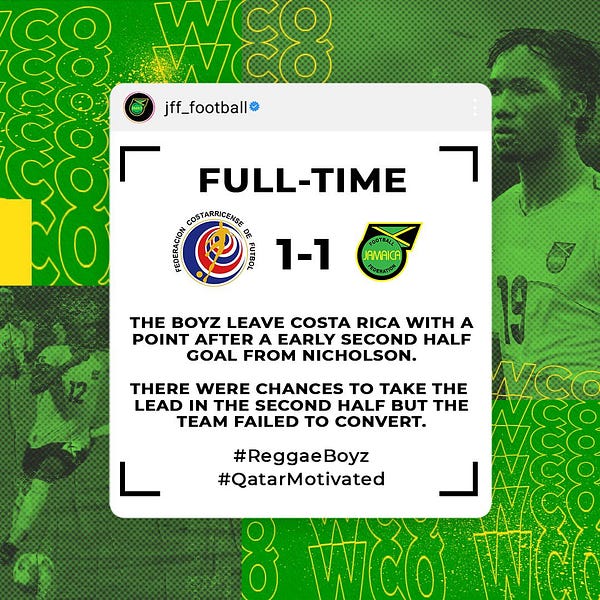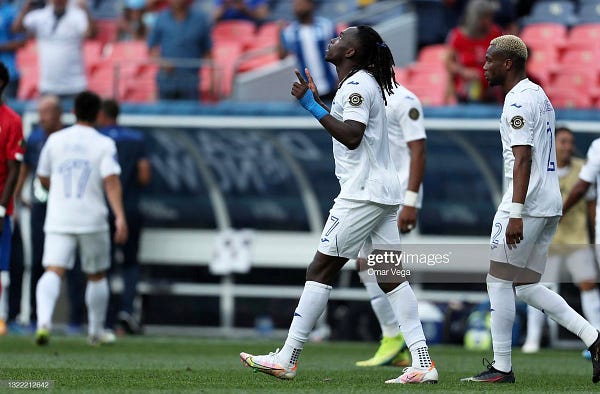Thoughts from the opening month of Concacaf WCQ's final round
Is everyone bad? Is everyone good? Let's dig in!
Thanks for Getting CONCACAFed, today and through out the first three MDs of the WCQs. If you’re not already subscribed you can do so here, or you can join the premium list for a special edition each Monday plus the occasional bonus feature. It helps me keep dedicating time to this newsletter!
We’re off and running in the final round of World Cup qualification in the Concacaf region.
Is qualification this time a marathon or a sprint? No one can seem to decide. For me, it’s the 3,000m steeplechase. You’re going to have to run as fast as you can for a really long time and, oh yeah, there also are enormous puddles of water and hurdles.
Whatever race you think qualification is most comparable to, we’re 3/14 through.
Here are a few thoughts after we saw all eight teams in action three times in just a week-long period:
What is the state of Concacaf?
AKA: What if everyone is bad?
The United States looked rough and came away sitting in third place in the table. Canada dropped points at home against the same Honduras team the U.S. beat and now sits second. Mexico didn’t look amazing in any of its matches but once again started qualification undefeated, with seven points from three matches.
Is it a ‘weak Concacaf’ this cycle? Or is this the world soccer equivalent of the SEC where great teams are cannibalizing each other and come the World Cup Concacaf teams will exceed expectations?
The early evidence suggests something in between. Every team has kinks to work out, and with the pandemic modifying the calendar (and making some players unavailable because of travel restrictions), it’d be unreasonable to expect teams - especially teams which sometimes haven’t played more than three or four meaningful games in the last year - to come out of the gate looking their best.
It’s hard to say how successful teams will be long-term this cycle. So much depends on players growing into roles the next year or managers figuring out how to get the best out of their teams sooner rather than later. Success at World Cups also depends on things like the draw (shout out Sweden 2018), cohesion in the group (France 2010) and even dumb injury luck.
Mexico and the U.S. have the personnel to not only top the heap in Concacaf but also to use the rhythm gained in qualification to challenge at the World Cup once they figure out the right XI and right tactical tweaks.
While the Central American sides may not have the same roster depth, and Costa Rica stumbled out of the gates under Luis Fernando Suarez, we’ve already seen some teams overachieve and after those anthems in El Salvador and the crowd at the Estadio Olimpico in Honduras we know there are still some daunting away days no matter what the unit on the field looks like.
And Jamaica? Well, let’s talk about Jamaica in the next section…
At least one manager is not making it through October
And it may be Theodore “Tappa” Whitmore. Expectations were high in Jamaica that Whitmore would lead the team back to the World Cup, a tournament he helped the Reggae Boyz qualify for in 1998 as a player.
Tappa wasn’t dealt a strong hand, only able to call upon his legion of UK-based players in one of three matches because of travel restrictions and having to utilize players based elsewhere in trips to Mexico and Costa Rica.
It was notable, then, that Jamaica was far worse in the Kingston match, a 3-0 loss to Panama, than in either of the two away contests. When Jamaica needed to step up and be the protagonist, it couldn’t do it, with holes in the squad and a lack of chemistry evident.


“We can sit all night and we can discuss technical and tactics, but for me, it was down to the commitment and the desire, especially in the first half. We were lackluster,” Whitmore said after the loss to Panama. “It was embarrassing to see what we did in the first half, and I think in the second half it was much, much better.”
The issue is that it’s rare Whitmore does discuss tactics, at least publicly, and it shows. Jamaica regularly is left to rely on a fluke goal, often from a counter-attack (see, at Mexico, at Costa Rica) to save face. A draw in Costa Rica may have boosted Tappa’s chances of keeping the job for a while, but the seat should still remain hot.
Not only is Whitmore’s squad struggling, there’s a ready-made replacement in Paul Hall already on the bench. Hall’s full-time gig is with QPR, and perhaps he has no desire to move on, but the country’s call can be tempting. He’s hardly the only candidate Jamaica could turn to.
Perhaps Whitmore turns it around, but the travel issues are likely to stretch on, and Jamaica meets the U.S. and Honduras on the road, sandwiched around a home match with Canada.
There will no doubt be urgency in both technical areas in that match against Honduras, with Fabian Coito also feeling the heat. Honduras was adequate in draws at Canada and El Salvador and played a good first 45 minutes against the United States.
You know the rest of the story, and while Ricardo Pepi and Co. certainly engineered the turnaround, Coito’s decision to bring in three halftime substitutes didn’t work out with Jose Garcia in particular having a night he’ll want to forget as quickly as possible.
Are other coaches safe? Not necessarily.
Gregg Berhalter’s gig truly felt in risk there at the midpoint of the Americans’ trip to Honduras, and Luis Fernando Suarez hardly has impressed leading Costa Rica - though you get the sense he has a longer leash with the federation than fans would like.
Panama powers through but also shows risk
Panama is in a stronger position than expected after the September matchday, still undefeated after a pair of home draws and that big win in Kingston.
The team looks very different from the one that made it to Russia in 2018, a momentous occasion for a country of 4 million that always has excelled more at baseball than on the soccer field. We knew the squad needed refreshing, but the question was where those players would come from - with the children dreaming to become the next Blas Perez, Jaime Penedo or Adolfo Machado not yet to become old enough to be pros.
The transitional generation looks pretty good, but it is not deep. Manager Thomas Christiansen opted for the same starting XI in all three matches and appeared to pay the price with Adalberto Carrasquilla coming out just seven minutes into the contest with Mexico after appearing to suffer a muscle injury (though the prognosis reportedly is less serious than it looked) and changes coming for Rolando Blackburn and Alberto Quintero - veterans who seemed spent - at halftime.
In addition to wanting players to be fit so they can play for their clubs without issue and continue earning their living, there’s also a selfish reason to keep players fresh: These guys are coming back in just a few weeks. Any long-term injury absence not only frustrates the player and the leaders at his club, it also stymies your own future plans.
Yet, what are managers supposed to do? Rotate! Buuuut, you can understand Christiansen’s plight here. The bench thins out pretty quickly, with the potentially to win utilizing, say, the 20th and 21st players on the depth chart dropping much more severely than if Mexico manager Tata Martino makes the same choice.
On some of the less deep Central American rosters, you get into untested domestic-based players quickly.
El Salvador manager Hugo Perez faced the same dilemma. He used the same team for the first two matches, getting a pair of home draws, but looked to be more aggressive in a road trip to Canada and saw a few of the new faces overmatched against Canada’s powerful attack.
So, who has the most to gain or lose from the next window?
Mexico and the U.S. both have a pair of home games, and with it the opportunity to pick up important points. The Americans stumbled out of the gates, but the top two teams in Concacaf still have an opportunity to put some distance between themselves and the rest of the pack if they can protect home field.
Honduras is the team in the ‘chasing pack’ I’d spotlight to keep an eye on in October. Alberth Elis is set to return, giving the team a boost on the top line, while Coito now better knows how to blend his squad, perhaps deeper than teams like Panama and El Salvador. Los Catrachos also have a pair of home matches, so if they don’t start moving up the table in October, they may never do it.


We’ll, of course, talk much more about that as the matches approach. Thanks for Getting Concacafed and we’ll talk Monday if you’re a premium subscriber, later in the week if you’re not. You can become one by clicking below!








Great read!